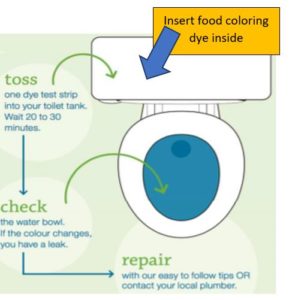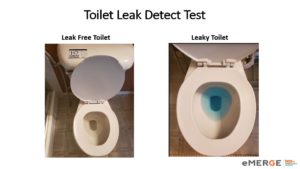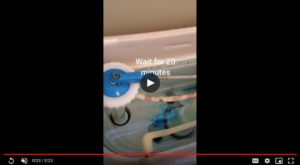To celebrate the 50th anniversary of Earth Day on Wednesday April 22, we want to talk toilets.
And we’re going to give you an activity that the kids can be part of too.
Does your toilet have a leak that you aren’t aware of?
Whenever we waste water we also waste the energy that was needed to pump the fresh water from wells, treat it for consumption and then pump the sewage and treat it again. In the end we use a lot of energy to do this and we consume a finite resource – water.
Your Mission, Should you decide to accept… Does your toilet have a leak?

Water Facts
- In Guelph, 11% of toilets leak water. This is the most common water leak in homes and can be particularly costly. They can waste between 144 and 700L per day. In comparison, the Guelph average residential water use is 167 L/person/day.
- The good news is most toilet leaks can be easily fixed.
- Leaks result from hard water deposits building up on flappers over time.
- Toilet leaks usually aren’t obvious to us. In some cases we can see the toilet continuing to re-fill long after it was flushed, or the bowl has visible water ripples in it or in advanced cases we can hear the sound of the water.
Toilet leaks occur when the water from the toilet tank continues to flow into the toilet bowl after the flush cycle has finished. As part of eMERGE Home Tune-up Program, we test all toilets in a home by using blue dye tablets. This test is called a ”Toilet Leak Detection Test”
It’s easy for you to do this at home.
- Place one dye tablet, or alternatively 2-3 droplets of food coloring (preferable a dark blue color) into the toilet tank.
- Wait for at least 20 minutes. Don’t flush the toilet during this time.
- Check the water in the toilet bowl, leaks are evaluated based on:

- If the bowl water turned colored, there is a leak. You can also see traces of the color as it appears in the toilet bowl coming from the sides.
- Light dye color means that you have minor leak that can be fixed by cleaning the flapper valve and the flapper seat with some vinegar so they fit snugly.

Toilet Recommendations
Note: Most toilets have flapper valves similar to the one pictured below. Newer toilets – especially dual flush models – frequently have very different mechanisms.

- Leaky toilets can be remedied by 1. cleaning the flapper valve in minor leaks 2. replacing the flapper valve (or other mechanisms) completely or replacing the toilet completely with major leaks.
- For minor leaks
- Add one cup of vinegar to the toilet reservoir. Let sit for 20 minutes then wipe any deposit build up from base of flapper and where the flapper meets the toilet. Re-test toilet for leak using the food coloring.
- If the water is still colored then: shut[1] the water off (see footnote below) to the toilet tank. The tap is usually located below the tank. Once shut: flush the toilet to remove all of the water from the tank. Then take a cloth soaked in vinegar and clean the bottom of the flapper valve (the part that comes in contact with the tank). Then, with the same soaked cloth, clean the portion of the tank (or mechanism) that comes in contact with the flapper valve.
- Turn the water back on and let the tank fill again. Redo the test. If the water is still colored, then the flapper is likely worn (degraded) and you need to replace it.
- For major a leak, a faulty toilet flapper should be replaced. Make sure you take the flapper with you to the store to ensure you have the correct part for replacement.
- If you still have a leak after checking these items and replacing the flapper then you may have to contact your plumber or replace your toilet. If you need to replace your entire toilet, look for a WaterSense labeled model with tank size less than 4.8 L and save BIG!
[1] Note that in some cases corroded shut off taps can fail if they haven’t been used in a long time. If it doesn’t close easily don’t do this.
The water lost through small leaks can add up. A small toilet leak of 0.1 liters per minute would lose 144 litres per day, an extra $160 per year on the water bill.
Note that the City of Guelph, like many other municipalities, does not have cost forgiveness policies for water lost through leakage, so it is in homeowners’ interest to monitor and manage leakage to avoid potentially significant costs.Now we have explained the toilet leak test mission, it is up to you to be part of this challenge and accept it. The mission is simple do the” toilet leak test”. Results will show either your toilet is a leak free or You have a leaky toilet. If you have a leaky toilet then join the ” Wall of Shame”. But remember to fix that toilet quickly.We’d love to hear how well you did and how you fixed any leaks. Send us your results here [email protected]



